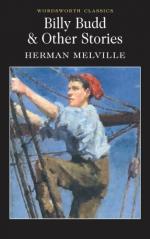|
This section contains 2,865 words (approx. 10 pages at 300 words per page) |

|
SOURCE: “The Hanging Scene in Melville's Billy Budd,” in Modern Language Notes, Vol. 70, No. 7, November, 1955, pp. 491–97.
In the following essay, Giovannini provides an interpretation of the hanging scene in Billy Budd which emphasizes the dualism of the story and rejects the conventional view of the ending as nihilistic and pessimistic.
In some recent scholarship on Billy Budd, and particularly in studies by [Joseph] Schiffman and [H. M.] Campbell, the irony in the hanging scene is urged against the generally held view that this last novel shows a changed and more or less orthodox Melville who has ceased to rebel.1 In Billy Budd we are to see the Melville of the earlier novels, still bitterly protesting against social and cosmic evil and making, according to Campbell, a compelling case in Billy's execution for a nihilistic belief in a doomed universe. Campbell construes the symbolic references to Christ's ascension and...
|
This section contains 2,865 words (approx. 10 pages at 300 words per page) |

|


